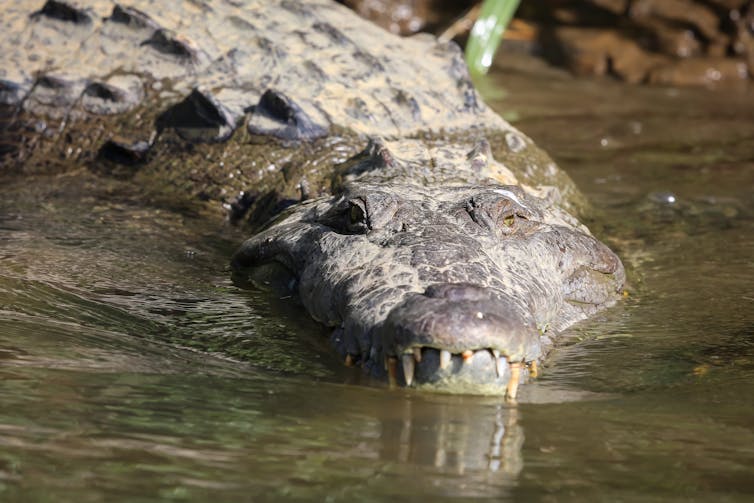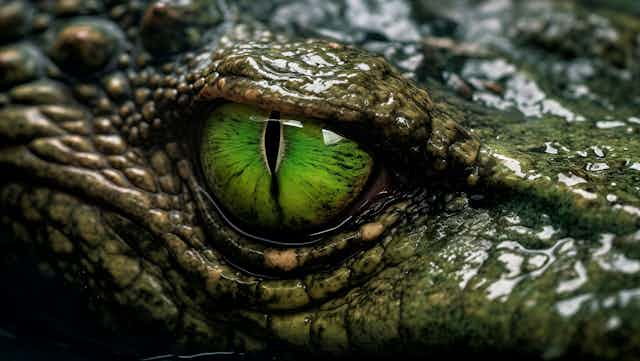Stories of virgin births, where young are produced without fertilisation, have been told throughout history. Mars the ancient Roman god, Horus the ancient Egyptian god and Qi from ancient Chinese mythology were all born to virgins. But virgin births actually do happen in the natural world.
The first evidence of a virgin birth in crocodiles has been reported in a captive American crocodile, Crocodylus acutus, who was housed on her own for 16 years in a zoo in Costa Rica. She laid a clutch of 14 eggs, of which seven seemed viable and were artificially incubated. The eggs failed to hatch and the contents of six of them were indiscernible. But one contained a fully formed foetus, genetically identical to its mother, showing no evidence of input from any males.
This isn’t the first case of a virgin birth in the animal kingdom. Baby lizards, snakes, sharks and birds, including the California condor, have all been documented hatching from unfertilised eggs.
How do we explain virgin births?
Species can reproduce either sexually, combining genetic material from two parents, or asexually. Our ancient ancestors were asexual and essentially made clones of themselves. Plants reproduce in a similar way, including splitting, budding and fragmenting.
However, this produces lots of organisms that are genetically identical, and a lack of genetic variation means that individuals cannot adapt to changing conditions. If the environment is bad for one member of a species, it is bad for all, and could lead to extinction.
Sexual reproduction in species such as humans needs sperm to fertilise eggs and create an embryo. In terms of evolution, sexually reproducing species are thought of as being more advanced, as their offspring are genetically diverse, with unique gene combinations from their parents.
This diversity can be important if a species needs to adapt. It also reduces adverse genetic mutations, which are often associated with inbreeding (when close relatives mate).

Virgin births are a form of asexual reproduction as they do not require genetic information from sperm. But, unlike other forms of asexual reproduction, they need an egg. Unfertilised eggs are often produced by females – you may have had unfertilised eggs for breakfast this morning from a domestic hen – and if unfertilised eggs aren’t eaten, they eventually perish. But there’s an exception. Virgin births, known as parthenogenesis, happen when an unfertilised egg develops into an embryo.
It won’t necessarily be genetically identical to the mother though – this depends on how the egg cell develops. Parthenogenic young can be either full or half clones of the mother. Half clones are produced when embryonic cells split in half before multiplying. Full clones are created when an embryo multiples whole cells.
So half clones have even less genetic diversity than full clones. Not only do they lack the genetic diversity of organisms created in sexual reproduction but they only inherit half of their mother’s genetic diversity.
Some species, termed facultative parthenogens, alternate between sexual and asexual reproduction. They rely mainly on sexual reproduction, but can use asexual reproduction if necessary.
Virgin birth, which usually results in female offspring, is thought to be triggered in several situations. For example, when there aren’t many males around. This is often reported in captive animals, including the bonnethead shark, where animals are kept in single-sex enclosures.
Passing on genes
Even when there are males around, females may still use parthenogenesis. For example, last year a female zebra shark hatched several young with DNA that did not match any of the males in the Chicago aquarium where she lived, baffling researchers. Perhaps the female simply didn’t fancy the males she lived with.
If environmental conditions are poor, asexual reproduction involves less effort than sexual reproduction, because the female doesn’t need to waste time and energy finding a mate. For example, many cases of parthenogenesis have been discovered in geckos, snakes and lizards that live in dry and harsh climates such as high altitudes.
Female animals can also reproduce asexually to take advantage of a favourable change in conditions. The spiny-cheek crayfish is native to the US but was introduced to Europe where the climate is more moderate. It invaded many European waterways by reproducing asexually. Although many invasive species are bigger and stronger than the locals, parthenogenesis is another factor that can contribute to their success.
Genetic testing technology that can identify parthenogenesis more readily is helping researchers discover that more and more species are capable of virgin births. The revelation of parthenogenesis in the American crocodile suggests there is a common ancestral link between the archosaurs, or ruling reptiles, which include dinosaurs, pterosaurs (flying reptiles), birds and crocodiles. As parthenogenesis occurs in the birds and crocodiles, it is possible that dinosaurs had virgin births too.
The virgin mother crocodile is eerily reminiscent of a scene in Jurassic Park when scientists claim there is nothing to worry about, that they can control the park’s population by ensuring all the dinosaurs are born female, so there won’t be any young produced naturally.
But in the words of the film’s chaos theory expert, Dr Ian Malcolm (played by Jeff Goldblum): “life finds a way”.


